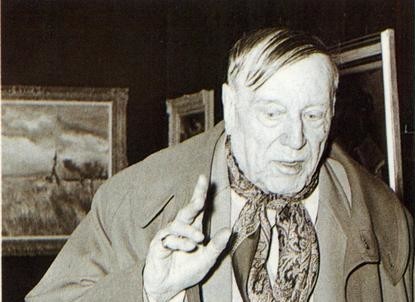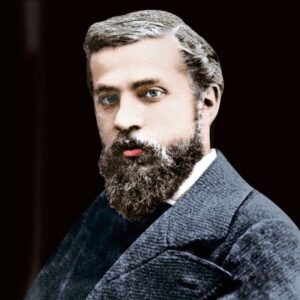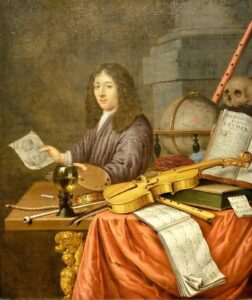Maurice de Vlaminck- Introduction
Maurice de Vlaminck was known for/as controversial Salon d’Automne exhibition (French painter). The birthplace of this artist is Paris. And this artist is the supporter of Fauvism because every painting of this artist shows the style of Fauvism art movement. Paintings such as “The River Seine at Chatou” and “The Seine at Chatou,” are some famous paintings of this artist.
Good painting is like good cooking; it can be tasted, but not explained.
Maurice de Vlaminck
Maurice de Vlaminck- Life
Maurice de Vlaminck’s life was a fascinating journey, characterized by artistic passion and diverse experiences. Transitioning from his early years as a musician, Vlaminck’s encounter with the works of Vincent van Gogh and Paul Cézanne ignited a profound interest in painting. This transformative shift led him to explore the vibrant world of Fauvism, where bold colors and expressive brushwork became hallmarks of his style.
Vlaminck’s bohemian lifestyle and friendships with prominent artists like André Derain and Henri Matisse enriched his artistic pursuits, fostering a sense of camaraderie and creative exchange. His deep connection to nature inspired a series of dynamic landscapes, capturing the essence of the changing seasons with a raw and emotive energy.
Throughout his life, Vlaminck continued to experiment with different art forms, including printmaking and ceramics, showcasing his versatility as an artist. His written works, encompassing novels and art criticism, shed light on the inner workings of his creative mind and the tumultuous art world of his time.
In conclusion, Maurice de Vlaminck’s life was a tapestry of artistic exploration, personal connections, and a relentless pursuit of creative expression, leaving an indelible mark on the vibrant and ever-evolving world of modern art.
This artist was also interested in
Maurice de Vlaminck- 2 Frequently asked questions
1. Why are Maurice de Vlaminck paintings so costly?
- The paintings of Maurice de Vlaminck remains in high demand, lovers like to purchase the painting of this artist. Following are some artworks of this artist.
- “The River Seine at Chatou”
- “The Seine at Chatou”
- “Houses at Chatou”
You can search these artworks of these Fauvism artists on- Artplode ( artwork), Artfinder (Fauvism paintings), Saatchi Art, Society6, and Artnet.
2. If I want to compare the artwork of this Fauvism artist, then whom should be compared with Maurice de Vlaminck?
There are so many artists of Fauvism. Perhaps, you may disagree with our comparison if you are an ardent follower of this artist. But in view of the area of activity such as controversial Salon d’Automne exhibition (French painter). We suggest you compare the artworks of Maurice de Vlaminck with the following artists:
- Andy Goldsworthy
- Angelica Kauffman
- Anni Albers
- Joan Miro
- Mark Rothko
Maurice de Vlaminck’s Artistic career
Maurice de Vlaminck’s artistic career was a journey defined by passion, experimentation, and evolution. Transitioning from his early days as a musician, Vlaminck’s encounter with André Derain and Henri Matisse marked a significant turning point. Inspired by their vibrant Fauvist style, he delved into painting, unleashing a bold and vivid palette.
As his career progressed, Vlaminck’s work underwent various phases, reflecting his exploration of diverse artistic movements. Transitioning from Fauvism, he delved into Cubism, infusing his compositions with geometric forms and fragmented perspectives.
Vlaminck’s artistic versatility was further evident in his foray into printmaking and sculpting, broadening his creative horizons and leaving a diverse body of work. His fascination with nature and landscapes led to captivating depictions of rural scenes, demonstrating a connection with the countryside that remained constant throughout his career.
Furthermore, Vlaminck’s venture into literature and art criticism showcased his intellectual depth and multidimensional talents.
In retrospect, Maurice de Vlaminck’s artistic journey exemplifies an unwavering commitment to experimentation, innovation, and creative expression, solidifying his place as a remarkable figure in the annals of modern art history.
Maurice de Vlaminck’s Artistic influences
Maurice de Vlaminck, a prominent Fauvist artist, drew inspiration from a diverse range of influences, shaping his unique artistic style. Transitioning from his early years as a musician, Vlaminck’s exposure to Impressionism during his time in Paris proved transformative. Immersed in the city’s vibrant art scene, he interacted with influential artists like Henri Matisse and André Derain, experiencing a profound shift in his approach to color and brushwork.
The vibrant and bold color palette of the Fauvist movement, along with the works of Vincent van Gogh and Paul Cézanne, further propelled Vlaminck’s exploration of vivid hues and expressive brushstrokes. Embracing the spirit of artistic freedom, he sought to evoke raw emotion and intensity in his paintings, creating dynamic and powerful visual experiences.
Moreover, Vlaminck’s admiration for primitive and non-Western art influenced his incorporation of simplified forms and primal energy into his works. This amalgamation of influences allowed him to forge a distinct style that embodied the essence of Fauvism while leaving an indelible mark on the trajectory of modern art.
In summary, Maurice de Vlaminck’s artistic journey was enriched by encounters with Impressionism, Fauvism, and non-Western art, ultimately shaping his bold and expressive oeuvre that continues to resonate with audiences to this day.

Maurice de Vlaminck’s Education
Maurice de Vlaminck’s education played a pivotal role in shaping his artistic journey, marked by unique experiences and transitions. Beginning with an early life steeped in poverty, Vlaminck’s passion for art led him to study at the École des Beaux-Arts in Paris. However, he soon grew disenchanted with the academic approach and sought inspiration from the works of Vincent van Gogh and other Post-Impressionists.
Transitioning away from traditional techniques, Vlaminck embraced a bold and expressive style, characterized by vibrant colors and vigorous brushwork. His encounters with fellow artists André Derain and Henri Matisse further enriched his artistic outlook, propelling him into the realm of Fauvism, an influential movement that celebrated vivid hues and emotional intensity.
Beyond the canvas, Vlaminck’s literary pursuits also played a role in his artistic development. As a poet and writer, So he conveyed his artistic vision through words, delving into the essence of creativity and artistic expression.
In summary, Maurice de Vlaminck’s education encompassed a trajectory of transformation, fueling his departure from conventional art and guiding him towards a path of artistic innovation and profound self-expression.
Know everything about Maurice de Vlaminck in
Maurice de Vlaminck’s Summary of this video
In this video, Maïthé Vallès-Bled explores the artistic evolution of artist, highlighting. His departure from Fauvism and his shift towards a more structured style. Vlaminck moved away from pure color and instead emphasized the organization of space in his paintings. However, he maintained the clarity of his subjects and continued to capture luminous effects and vibrant contrasts. While Vlaminck experimented with form and composition, he did not delve into Cubism or abstraction.
Information through
In this article, you got the answer of following questions- Frequently asked questions:-
- Who is Maurice de Vlaminck and why this artist is so famous?
- What are the notable artworks of Maurice de Vlaminck?
- What are Maurice de Vlaminck most famous artworks of? And why, these are so costly?
- What are some interesting facts about Maurice de Vlaminck?
- What are the most important sections of the life of Maurice de Vlaminck which anybody should know?
You knew about the most important section of the life of an artist, how the artistic career starts from the first part and ends at the second part. These important sections are:- contentos You read almost everything about this artist. But still, if you want to read more about Fauvism and Maurice de Vlaminck then you may read the following articles:-
- Maurice de Vlaminck – Biography | short notes | Top artworks.
- Maurice de Vlaminck – Life, paintings, contribution, death.
- Maurice de Vlaminck – Short notes | Know everything in seconds.
- Maurice de Vlaminck – Facts, Overview, complete life- At a glance.
These articles cover the whole artistic journey of this artist comprehensively.
Exhibition list
Exhibition List of Maurice de Vlaminck:
- Salon des Indépendants (1905) – Debut exhibition showcasing bold and vibrant paintings.
- Group Exhibitions with Fauvist Luminaries – Displayed expressive works alongside Matisse and Derain, challenging conventions.
- Salon d’Automne and Salon des Tuileries – Participated in group exhibitions, solidifying avant-garde reputation.
- Incorporating Cubism – Embraced elements of Cubism in evolving artistic style.
- Retrospectives and International Exhibitions – Paintings featured in major showcases, enhancing his renown as a modern artist.




